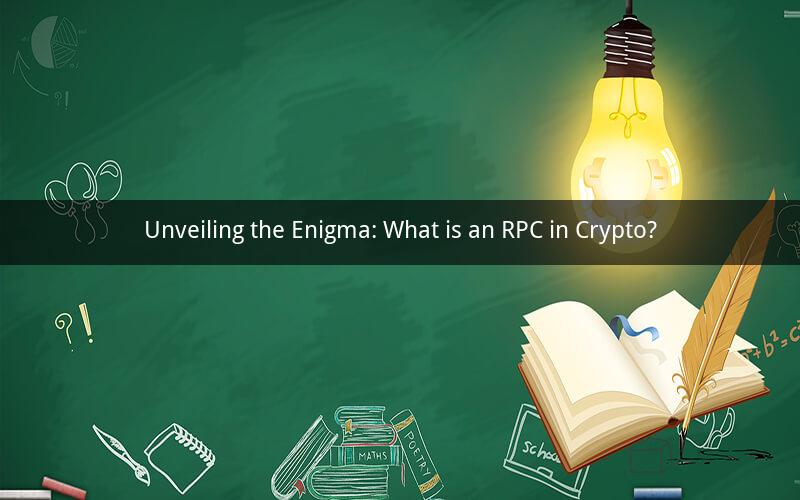
In the world of cryptocurrencies, various terminologies and concepts are often thrown around. One such term that might leave beginners scratching their heads is "RPC" or Remote Procedure Call. This article aims to delve into the depths of what an RPC in crypto stands for, its significance, and how it functions within the crypto ecosystem.
What is an RPC in Crypto?
RPC, in the context of cryptocurrencies, refers to a protocol that enables two computers to communicate with each other remotely. It allows a client to invoke a procedure on a server and receive the result without knowing the server's internal implementation. In simpler terms, it's a way for different software applications to interact with each other over a network.
RPCs are widely used in various domains, including web services, gaming, and, of course, cryptocurrencies. In the crypto world, RPC plays a crucial role in enabling seamless communication between different components of a blockchain network.
How RPC Works in Crypto
To understand how RPC functions in the crypto space, let's take a closer look at its components and the process it follows.
1. Client: The client is the application or software that initiates the RPC request. It could be a wallet, a trading bot, or any other crypto-related application.
2. Server: The server is the blockchain network or a specific node within the network that processes the RPC request and returns the result.
3. Request: The client sends an RPC request to the server, specifying the procedure it wants to invoke and any necessary parameters.
4. Response: The server processes the request, executes the specified procedure, and sends back the result to the client.
5. JSON-RPC: RPC in the crypto world primarily uses JSON-RPC (JavaScript Object Notation-Remote Procedure Call) as the communication protocol. JSON-RPC is a lightweight and widely adopted protocol that allows for easy interaction between different software applications.
Significance of RPC in Crypto
RPC holds immense importance in the crypto world for several reasons:
1. Decentralization: RPC enables decentralized applications (dApps) to interact with blockchain networks without the need for a centralized intermediary. This fosters a more transparent and secure environment.
2. Interoperability: RPC allows different blockchain networks and applications to communicate with each other, promoting interoperability and seamless integration.
3. Scalability: RPC enables the creation of scalable and efficient blockchain networks by allowing various components to interact with each other without the need for complex and resource-intensive communication protocols.
4. Accessibility: RPC makes it easier for developers to build and deploy crypto applications by providing a standardized and efficient way to interact with blockchain networks.
5. Flexibility: RPC allows developers to customize and extend their applications by invoking various procedures on the blockchain network.
Common Use Cases of RPC in Crypto
1. Wallets: RPC enables wallets to interact with blockchain networks, allowing users to send, receive, and manage their cryptocurrencies.
2. Exchanges: RPC facilitates the integration of exchanges with blockchain networks, enabling them to provide real-time trading data and execute transactions.
3. dApps: RPC allows dApps to interact with blockchain networks, enabling users to access decentralized services and applications.
4. Mining Pools: RPC enables mining pools to communicate with blockchain networks, allowing them to manage and optimize their mining operations.
5. Smart Contracts: RPC allows smart contracts to interact with blockchain networks, enabling developers to create and deploy decentralized applications.
Frequently Asked Questions (FAQs)
1. What is the difference between RPC and REST in the context of crypto?
Answer: RPC (Remote Procedure Call) and REST (Representational State Transfer) are both communication protocols used in the crypto world. The primary difference lies in their underlying architecture. RPC uses a more structured and synchronous approach, while REST is based on a stateless, asynchronous architecture.
2. Can RPC be used for secure communication in crypto?
Answer: Yes, RPC can be used for secure communication in crypto. By implementing appropriate security measures, such as encryption and authentication, RPC can ensure that the communication between clients and servers remains secure.
3. How does RPC contribute to the scalability of blockchain networks?
Answer: RPC enables different components of a blockchain network to communicate efficiently, which in turn contributes to the overall scalability of the network. By allowing various applications and services to interact with the network without the need for complex and resource-intensive protocols, RPC promotes a more scalable and efficient blockchain ecosystem.
4. Can RPC be used for off-chain transactions in crypto?
Answer: Yes, RPC can be used for off-chain transactions in crypto. Off-chain transactions refer to transactions that occur outside the main blockchain network but are eventually recorded on the blockchain. RPC can facilitate the communication between off-chain systems and the blockchain network, ensuring that off-chain transactions are properly recorded and validated.
5. Is RPC a protocol or a technology?
Answer: RPC is a protocol. It defines the rules and standards for communication between different software applications over a network. RPC can be implemented using various technologies, such as JSON-RPC, XML-RPC, and others.
In conclusion, RPC plays a vital role in the crypto world by enabling seamless communication between different components of a blockchain network. By fostering interoperability, scalability, and security, RPC has become an indispensable tool for developers and users alike. Understanding the basics of RPC can help you navigate the complex world of cryptocurrencies with greater ease and confidence.